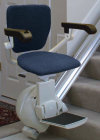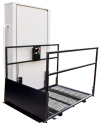Mobility Lifting Aids Compared
Published by Stephen on November 4, 2008 Under stair liftsUsing the stairs is something that is not only very dangerous, but can often be quite hard for an individual. Falls can affect all age groups, but predominantly those over sixty are at the highest risk of a fall or accidental death on the stairs. Since staircases can be so dangerous, it is very important to prevent falls, especially among seniors.
There are several devices available for people who can not safely use the stairs.
Stair Lifts:
 The stair lift is one of the most popular mobility aids that is used to prevent falls on the stairs. It attaches to the stairs and a person can then move themselves up the stairs using a small chair or platform. They use regular household current, but some include battery backups.
The stair lift is one of the most popular mobility aids that is used to prevent falls on the stairs. It attaches to the stairs and a person can then move themselves up the stairs using a small chair or platform. They use regular household current, but some include battery backups.
Stair Lift Advantages:
- Easy install for straight staircases
- Cost Effective, usually less than $3,000
- Supports over five hundred pounds
- Safe and reliable
Stair Lift Disadvantages:
- Cannot easily handle mobility vehicles, like wheelchairs
- Takes up space on the stairs
Residential Elevator:
 A residential elevator is an elevator that has been designed to be installed into a home. Many can be installed into a wooden framed home, without the need for a concrete shaft. A car is sent in between floors carrying a rider.
A residential elevator is an elevator that has been designed to be installed into a home. Many can be installed into a wooden framed home, without the need for a concrete shaft. A car is sent in between floors carrying a rider.
Residential Elevator Advantages:
- Very Functional, can be used to transport people in wheelchairs and household goods.
- Able to support a good deal of weight
Residential Elevator Disadvantages:
- More expensive, but some of this can be retrieved when the home sells
- Requires a rather serious home renovation
Vertical Platform Lifts:
 A vertical platform lift, or wheelchair lift, is very similar to an elevator. The difference is that the wheelchair lift is smaller and completely self contained. It is designed to lift a platform vertically up to the top of the stairs. These can lift up to twelve feet in the air.
A vertical platform lift, or wheelchair lift, is very similar to an elevator. The difference is that the wheelchair lift is smaller and completely self contained. It is designed to lift a platform vertically up to the top of the stairs. These can lift up to twelve feet in the air.
Wheelchair Lift Advantages:
- Easy and quick to install
- Can quickly provide wheelchair access to a set of stairs similar to a front porch
- While they cost more than a stair lift, it is less expensive than an elevator.
- Little home modification required
- Portable models available
Wheelchair Lift Disadvantages:
- Harder to use on interior staircases.
No Comments |
Add a Comment